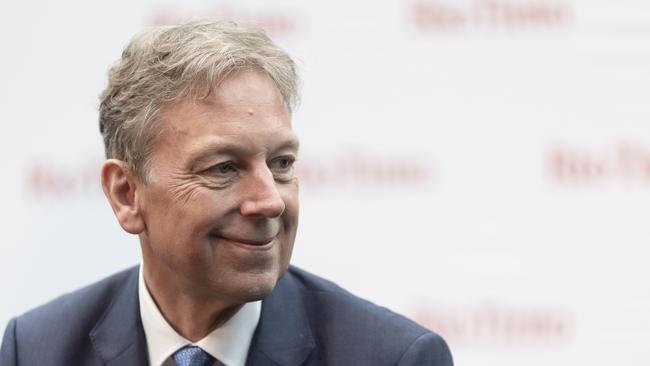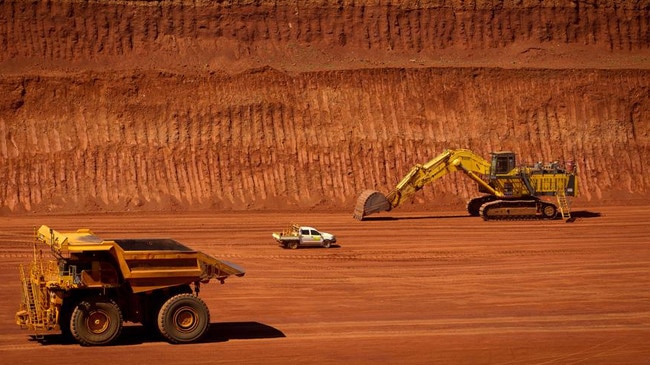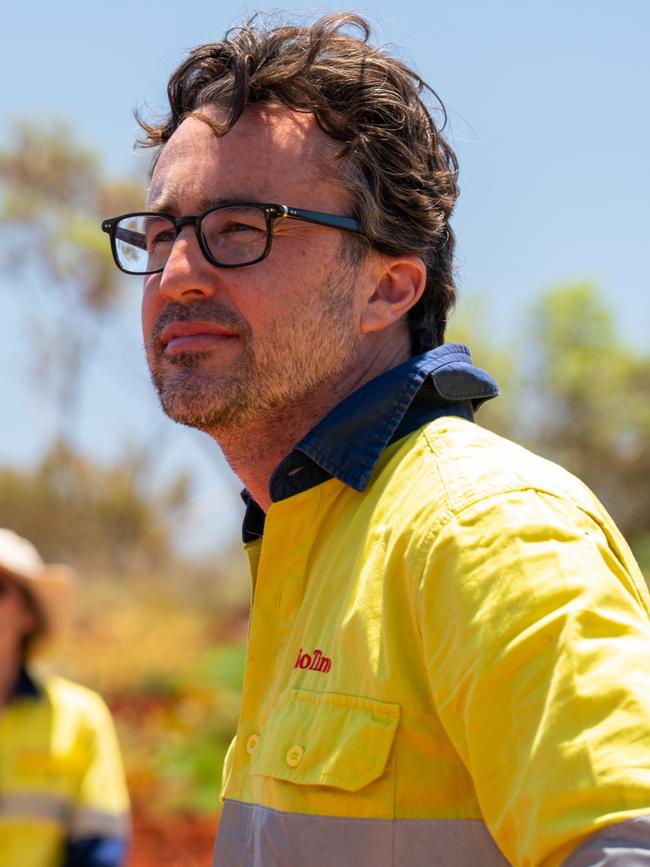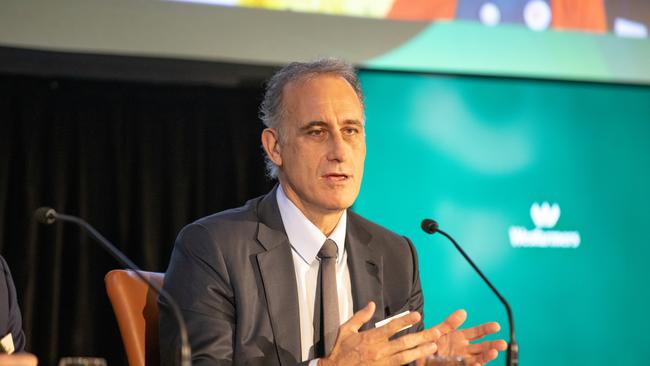
Rising tensions between the CEO and chair Dominic Barton over the direction of longer-term strategy is one thing, however tier one miners like Rio rise and fall on the strength of their long-term planning.
Rio’s surprising lack of succession planning or smooth handover is a failure of board oversight, and this will be enough to stir worries that the governance ghosts of the miner’s recent past still remain.
Barton needs to come clean on why his highly considered CEO has gone after a little over four years, and this comes just weeks after both fronted two separate annual meetings in London and Perth and pegged a round of shareholder meetings on the back of that.

The exit also comes days after Stausholm was preparing to double down on his lithium bet, forging a $US900m joint venture with Chile’s Codelco.
Barton has told investors this is a “natural moment” to appoint Stausholm’s successor, with a selection process “already underway”. Both of these assertions are hardly grounded in logic.
Although Stausholm has committed to remain on until later this year, Rio’s board is clearly on the back foot and only just beginning the search for his replacement. If Barton looks past internal contenders, including front-runner iron ore boss Simon Trott, chief commercial officer Bold Baatar and minerals boss Sinead Kaufmann also in the mix, then finding an outside candidate could take months. Rio has guided staff they should be in a position around October.
If the talent comes from a rival miner, non-compete restrictions mean it could take even longer in getting the new boss into Rio Tinto.
Stausholm took charge of Rio in the midst of a crisis. The former Rio chief financial officer and one-time Shell and shipping executive set about cleaning up from the extensive mess of the Juukan Gorge cave crisis.

As well as mending political bridges to make sure Rio wasn’t entirely stripped of its social licence, he forced the company to confront the ugly side of its mining culture and set the process underway to change that. It will still take time.
Stausholm brought an era of peace to Rio Tinto, something it hadn’t seen since the days of legendary bosses Leigh Clifford and Leon Davis. This peace was a welcome confidence boost, allowing Rio to deliver annualised production growth across key copper and iron ore metals, reversing a decade of shrinking output.
With the company in crisis, his first actions as CEO were faultless. He invested the time in Australia and set off on a listening tour meeting hundreds of staff, politicians including state and Indigenous partners. Where Rio had increasingly been run from the London head office, Stausholm sought to reacquaint Rio with its glory days, spending time with both Davis and Clifford as well as John Ralph, the boss of Rio’s Australia predecessor CRA. Combined, these three were the architects of the modern day miner.
As well as sending a message the company needed to change, he also embraced it and empowered the front line workforce to drive the necessary cultural and operational change.
Stausholm used Rio’s crisis to make the tough structural calls. He tackled the inefficient ownership structure of the copper business and reset a once-strained relationship with Mongolia over the massive Oyu Tolgoi mine. This is now giving Rio a copper future when it most needs a credible growth story.

Stausholm also inserted himself in the complex negotiations with Guinea, and now after decades of inaction one of the world’s richest iron ore deposits is being developed at Simandou. Rio’s Pilbara mines are starting to lose their quality, where potentially Rio was too cautious on moving ahead on expansion. He has also publicly backed an energy retooling of the miner’s Australian east coast aluminium smelters, where it would have been easier to pull the plug.
What is less than certain is Stausholm’s aggressive bet on lithium, and this may emerge as a pressure point for his eventual successor. While his push into lithium is at the lower end of the cost curve, there is still doubt over the longer term fundamentals of the market.
The foundation however for Rio has been the stability Stausholm has brought to the global miner. The miner’s board has risked this and more, by moving too fast.
Digital world
Taking on the likes of Amazon or Temu at their own game is either delusional or at best ambitious.
Australia’s biggest retailer wants to go head-to-head with these global e-commerce kings, and reckons brands that are decades old with big legacy store footprints are the ones best placed to do it.
Wesfarmers, the owner of hardware juggernaut Bunnings as well as discount department stores Kmart and Target, has spent the past few years quietly building up a powerful digital engine. It might have been late to the digital game, but helped with balance sheet heft, Wesfarmers is catching up.
Wesfarmers chief executive Rob Scott now reckons gains on digital and data combined with his near 1900 store network is increasingly delivering a competitive advantage against pure online rivals in the retail fight.

Today nearly $3bn of Wesfarmers’ total retail sales are via online channels and this is growing at a faster clip than its real world sales. But Scott says the real strength is at the back end. He has more than 35 massive distribution warehouses across the country and combined with store footprint, this equals 7.5 million square metres of space, several times the size of Amazon in Australia.
Loyalty schemes including Priceline, the 50 per cent owned Flybuys and the paid OnePass scheme count 12.5 million members, giving more data.
“If I go back seven years, our e-commerce capabilities were fairly nascent. We didn’t have a lot in terms of data and digital capabilities. Now we feel that we’ve got some amazing capability and systems there and amazing customer data assets,” Scott says.
Scott was talking to The Australian on the sidelines of a strategy day in Sydney. The message from Wesfarmers is the conglomerate talking about growth again.
He was speaking from a position of strength, with Wesfarmers shares this week touching a record high of $83.11 Wesfarmers shares have added more than 20 per cent since April as investors were betting with more certainty the RBA would push through more interest rate cuts this year.
As one of Australia’s biggest retailers, the bulk of Wesfarmers’ is leveraged to the level of interest rates.
Billions in spending on healthcare through Priceline, digital and building up lithium are now moving from an investment phase to a point where they will stop becoming a drag and start making a positive contribution to Wesfarmers’ overall returns.
It’s been an expensive exercise getting to this point. Kmart is taking over the automated warehouses and fulfilment operations of Wesfarmers’ now defunct Catch. Scott paid $230m for catch in 2019, and invested even more in building up the business as a standalone player. He pulled the plug last year and folded the supply chain operations into Kmart.
Scott concedes Catch was acquired at a time when Wesfarmers’ e-commerce capabilities were “fairly basic”. At the time the belief was there could be an opportunity for a standalone pure play e-commerce provider to sit alongside its other real work brands.
“The world’s fundamentally changed, and what we’ve learned through that process is it’s not about having a standalone e-commerce business, it’s about building capabilities that are relevant for our businesses”.




The management upheaval set to follow Jakob Stausholm’s ousting from Rio Tinto undercuts the Danish chief executive’s hard won gains in bringing much needed-stability to the global miner.